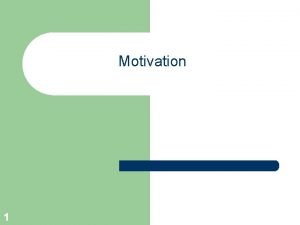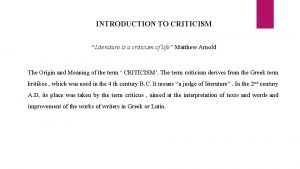Narcissism Intrinsic and Extrinsic Romantic Ideals and Relationship

- Slides: 1

Narcissism, Intrinsic and Extrinsic Romantic Ideals, and Relationship Satisfaction Gwendolyn Seidman For a copy of the paper (forthcoming in Journal of Social and Personal Relationships) email gseidman@albright. edu or download the online first version at http: //spr. sagepub. com/content/early/2015/11/17/0265407515615693. abstract Albright College Ideal Standards Model • According to the ideal standards model, the closer one’s actual relationship is to one’s ideal standards, the more positively one views that relationship (Campbell et al. , 2001; Fletcher et al, 2000 a). • Rodriguez and colleagues (2015) classified relationship domains into intrinsic (warmth/ loyalty) and extrinsic (vitality/status/passion) qualities. • Relationship quality is better predicted by having a partner/relationship that meets intrinsic than extrinsic ideals (Rodriguez et al. , 2015). Hypotheses Hypothesis 1: Narcissism will be positively associated with extrinsic ideals, and negatively associated with intrinsic ideals. Hypothesis 2: The extent to which current partners meet intrinsic ideals will be positively associated with relationship quality, especially for non-narcissists. Hypothesis 3: The extent to which relationships meet extrinsic ideals will be positively associated with relationship quality for those high, but not low, in narcissism. Hypothesis 4: For narcissists, the extent to which relationships meet extrinsic ideals will better predict satisfaction than the extent to which they meet intrinsic ideals. Hypothesis 5: These effects will be driven by Grandiose Exhibitionism and Entitlement/Exploitativeness, but not Leadership/Authority. Sample Characteristics: • 79% female • 79% undergraduates • Age: M = 23. 33, SD = 9. 31 • For the 143 romantically involved Ps, average relationship length was 5. 63 years (SD = 9. 69). • Correlations were computed between NPI scores and ideal ratings, as were partial correlations controlling for the other ideals (N=206). • Multiple regression analysis was conducted with relationship quality as the criterion variable (N=143). • Predictors: Actual and ideal ratings, NPI score, interactions between narcissism and actual partner/relationship ratings. ▫ The model controlled for gender and relationship length. Continuous variables were mean-centered. • In an additional multiple regression model, each facet of narcissism was used as a separate predictor. Measures • Narcissistic Personality Inventory (Raskin & Hall, 1979) • Ideal Standards Questionnaire (Fletcher et al. , 1999). All Ps rated their ideal partner and relationship on 7 -point Likert scales in 5 domains: • Intrinsic domains: • Intimacy/loyalty (e. g. , commitment, respect) • Warmth/trustworthiness (e. g. , kind, honest) • Extrinsic domains: • Vitality/attractiveness (e. g. , outgoing, sexy) • Status/resources (e. g. , successful, good job) • Passion (e. g. , exciting, fun) • Romantically involved Ps also rated their current partner/relationship on these 5 domains. • Perceived Relationship Quality Components inventory (Fletcher, Simpson, & Thomas, 2000 b) assessed six components of relationship quality: Satisfaction, commitment, intimacy, trust, passion, and love. Relationship Quality Predictor (R 2 =. 668***) B (SE) Narcissism 0. 013 (0. 007) † Ideal intrinsic -0. 210 (0. 130) Ideal extrinsic -0. 018 (0. 136) Actual intrinsic Actual extrinsic 0. 764 (0. 133)*** 0. 261 (0. 140) † -0. 054 (0. 017)** Narcissism X Actual extrinsic 0. 055 (0. 018)** Predictor (R 2 =. 687***) 0. 058 (0. 019) ** LA X Actual intrinsic -0. 064 (0. 043) LA X Actual extrinsic -0. 024 (0. 044) Entitlement/Exploitativeness (EE) -0. 009 (0. 052) EE X Actual intrinsic -0. 273 (0. 120)* EE X Actual extrinsic 0. 247 (0. 117)* Grandiose Exhibitionism (GE) -0. 020 (0. 023) GE X Actual intrinsic -0. 077 (0. 058) GE X Actual extrinsic 0. 153 (0. 065)* Partial r Extrinsic . 290*** . 369*** Vitality/attractiveness . 333*** . 293*** Status/resources . 127† -. 032 Passion . 246*** -. 081 . 037 -. 242*** Warmth/trustworthiness . 043 -. 156* Intimacy/loyalty . 027 -. 035 Intrinsic 8 7 7 6 5 4 3 2 Low Narcissism 1 High Narcissism 6 5 4 3 2 Low Narcissism High Narcissism 1 0 0 B (SE) Leadership/Authority (LA) r 8 Low Intrinsic Narcissism X Actual intrinsic Ideals Low Extrinsic High Intrinsic 8 8 7 7 6 6 5 4 3 Low Entitlement/ Exploitativeness High Entitlement/ Exploitativeness 2 1 0 Low Intrinsic High Intrinsic Relationship Quality • According to the Agency Model of narcissism, narcissists adopt a self-regulatory style to maintain inflated self-views, and behavior in romantic relationships is one aspect of this general self-regulatory style (Brunell & Campbell, 2011; Campbell et al. , 2006). • Narcissists have an agentic, rather than communal value system (Campbell et al. , 2002). • Narcissists prefer “positive” rather than “caring” traits in romantic partners (Campbell, 1999). 206 Ps completed an online survey. Correlations: Narcissism and Ideal Standards Data Analysis Relationship Quality Narcissism & Partner Preferences Sample and Procedure Results Relationship Quality • Narcissism, originally conceptualized as a clinical disorder, characterized by an inflated, grandiose selfconcept (APA, 2013), has been applied to non-clinical populations (Raskin & Hall, 1979). • Narcissism is multi-faceted, consisting of Leadership/ Authority (which is generally adaptive), Grandiose Exhibitionism, and Entitlement/Exploitativeness (Ackerman et al. , 2011). Method Relationship Quality Narcissism as a Personality Trait High Extrinsic 5 4 Low Entitlement/ Exploitativeness High Entitlement/ Exploitativeness 3 2 1 0 Low Extrinsic High Extrinsic *** p <. 001, ** p <. 01, † p <. 10 Conclusions • As predicted, narcissism was associated with extrinsic ideal relationship preferences. • For non-narcissists, the extent to which relationships met intrinsic ideals, but not extrinsic ideals, was positively associated with relationship quality, as their relationships are used primarily to satisfy communal goals. • Relationships meeting extrinsic ideals were more satisfying for narcissists, but non-narcissists, consistent with the Agency Model of narcissism. • The effect for extrinsic traits was driven by Entitlement/Exploitativeness and Grandiose Exhibitionism, and the effect for intrinsic traits was driven by Entitlement/Exploitativeness.

